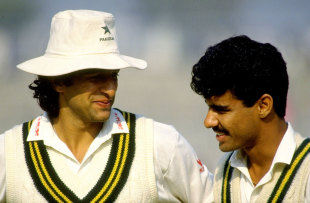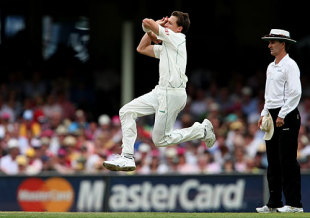| 
| "Bowling is all about bringing the batsman forward: you have to make him come at least halfway in front, keep him guessing" © Getty Images |
| Enlarge
|
|
|
|
Is swing bowling an art in decline?I do not think it is dying, because there are a lot of bowlers who can swing and know how to master it. The art that is in decline is pace, especially in the subcontinent. We do not really find fast bowlers who can bowl consistently at a rapid pace. Young bowlers come into cricket bowling at 140-145kph before fading away in a year or two. Irfan Pathan, Ishant Sharma are two good examples. Pakistan may be an exception because their youngsters follow fast bowling much more closely. Fazal Mahmood,
Imran Khan,
Wasim Akram, myself are heroes to many youngsters. In India it is the batsmen that a youngster normally idolises.
With the bowlers - they enter with an aggressive mindset but over the years the pace goes down.
What are the requirements for a good swing bowler?
You need a combination of a good action, timing, rhythm and energy. Swing bowling is not at all about slowing down or increasing the pace. And it is not only about the seam position and the roll of the wrists.
The very basic of swing bowling is your action. You need to have a really good action. It does not really matter whether you are side-on or front-on. If the timing of the release of the ball is perfect, then it will swing, regardless of the playing conditions. I hear TV commentators saying the seam position was good, so why did it not swing? That is because there was something amiss in the release or in the action. The wrist position is important when you talk about swing bowling.
What is the appropriate wrist position?
The fingers should be right behind the ball. When the ball comes out of the hand, the seam should be upright. For that your wrist needs to be straight at the point of release. If it is not straight, it will stop swinging. You might be able to bowl quick but it will be up and down.
Can you give an example?
Pakistan fast bowler Wahab Riaz is a good example of a bad wrist position. His wrist breaks at the time of delivery. He is a good case of other things not being in order, due to which his wrist breaks. At the crease he is not balanced and then he has to push the ball really hard. Then his head falls and the wrist breaks. Your body position at the crease while you are delivering the ball needs to be correct.
Do you lose control of swing if you are trying for pace?
I do not agree at all. That is a wrong idea completely. Look at Dale Steyn. He bowls at 150kph-plus and he swings it big. Big bananas come out of his hand. His wrist is in such a beautiful position when the ball comes out, and all his energy is going through the crease nicely. That last part is due to his fitness.
Fast bowling is not an easy art. You need to have a brain, you need to be smart to understand what bowling is all about.
I can give you my own example when I first started playing for Pakistan. I was lucky that I had other senior fast bowlers who were really doing well, and I had a bit of competition with them. I also had Imran Khan use me nicely. He understood me better than myself. I did not have any idea what fast bowling was. All I knew was to bowl fast. It is important to have someone who can guide the youngster and tell him it will come. But it takes a lot of time to master the art.
Can you revisit those days of Waqar Younis, the young fast bowler, and how Imran shaped you?
Sometimes it is good not to know too many things. When you see a fast bowler trying too many things, it is not good for his future. I was lucky that I knew only one thing, to bowl fast. Whenever I asked Imran what I should do, he only said, "Hold on, you don't really need to do anything. I just want you to bowl quick. That is it." That really worked for me because he wanted me to become a fastbowler, not a medium-pacer.
The first six years of my career, I was really quick. Imran would use me in the middle overs, so I could get the ball to reverse. Reverse is a touch easier than conventional swing, because the ball is in your control more than when you are bowling normal swing. He used me smartly for the three years he was there, before he quit the game in 1992. By then I knew the tricks. Later
Aaqib Javed was bowling with the new ball for a few years. By the time he faded away, I was ready to deliver with the new ball. So I went through all the phases: quick bowling, reverse swing and then the new ball.
Nowadays a youngster at the age of 21 tries to do different things immediately on entering international cricket. They try to learn too many things too quickly. But I again point out the example of Steyn: he does one thing, the outswinger, and he is very successful. He keeps it simple. Batsmen are scared of him because the ball comes at 150-plus.
So in those first six to seven years, were you not a complete fast bowler?
In those first six to seven years I was in the team, but I did not know much about bowling. I learned a lot about fast bowling by asking Imran. Me and Wasim would stand at mid-off and mid-on, good positions to learn about what the bowler is trying, and we would talk to each other and quickly grasp the subtleties. For about the first five seasons I was not given the new ball. I would bowl with a new ball in the nets but not in the match. I would be the fourth bowler in the attack because Imran would only bring me on when the ball started to reverse. I would keep wondering why he passed me the ball when it was 25-30 overs old. But it worked for me and now I understand why he did what he did.
We did the same thing with Shoaib Akhtar when he broke through the ranks. It was unfortunate injuries and other stuff that sidelined him, because he was a true match-winner.
| | | | |
| |
| "Whenever I asked Imran what I should do, he only said, 'Hold on, you don't really need to do anything. I just want you to bowl quick. That is it'" |
| |
| | |
|
What is the difference between bowling with the new ball and the old ball?
It always helped me, going from the old ball to the new ball. The other way around is harder: it decreases your pace as a bowler, because with an older ball you bowl quick and tend to add an extra yard or two of effort. But when it comes to a new ball, you could sort of cut down on pace a little bit. I started bowling with the new ball around 1995. By then I knew more about what my body requires, how much rest I need, how much I can bowl. Now this is done by the coaching staff. We used to monitor ourselves on our own.
Learning in the nets is a vital part of development for every fast bowler. What was your training regimen like?
I broke down a couple of times in my career. Every bowler breaks down at least once, but I broke down after doing really well on the field. People rely on the gym more now than during our times. I am not saying that is wrong. It has done wonders in terms of strength, conditioning and looks. But do bowlers have enough gas in their tanks, especially in the subcontinent, to keep going? I fear people will continue to break down.
So the point I am driving is: focus on the basics. Bowling and running were major parts of my training. I did very little gym because nobody was there to tell me that it could have helped with my strength. I guess that helped me in a way, because my body would not have coped with going to the gym and then bowling. The kind of action I had, which was very side-on, I needed to be flexible and have an elastic body. We were jogging, running, sprinting freaks. When Imran was there, we would run five laps before we did anything. Being in the gym - it was all about looking good.
Do you agree that stamina is more important to a fast bowler than anything else to generate speed?
Stamina and endurance always help. You just need to have a heart to keep running. My bowling was my training, because I had a long run-up and I would bowl a good six to seven overs on the trot and then have a break of 30-40 minutes before returning for a short burst of three overs. All that without bowling a no-ball. Even Aaqib and the rest of that lot, we just ran fast. We used to tell each other: we are not bowling a no-ball, even in the nets. We are going to bowl within our limits and then try and trouble the batsman. Even now as a coach I tell the guys never to bowl a no-ball in the nets. It puts all your energy and effort to waste otherwise.
Are fast bowlers more protected now?
Biomechanists probably would disagree with me, but based on my experience, most fast bowlers in the 1980s and '90s never had people telling us to change or modify our actions, and that if we did not do it we would break our backs. Your body is your best judge. It learns over a period of time to adapt. These days Level 3 and 4 coaches put a lot of emphasis on certain specifics due to the numerous video cameras that have come into play. But I have always believed in allowing the bowler to play with his body and understand the best position and action for himself.
Take the case of
Ishant. When he first came on the scene, I thought: here is a good bowler with an open-chested action, tall and hits the deck and gets bounce. Then he started making changes in his action, going wider, started losing pace and rhythm. He is looking better now, but in the last two years he had lost it. I do not know whether it was the coaches who tried fiddling with him or whether it was his own decision.
What was he doing wrong?
He did not get wickets because he was bowling a little short of length. He reminds me of Javagal Srinath, who bowled a similar length throughout his career. With his body and the momentum he generated through his run-up, Srinath should have taken a lot of wickets, but he did not pitch the ball up. Venkatesh Prasad, with limited ability, pitched it up and did well.
Bowling is all about bringing the batsman forward: you have to make him come at least halfway in front, keep him guessing. Unless you are playing on fast pitches, like Perth of the past, there is no point pitching back of a length. Young fast bowlers in the subcontinent predominantly play on flat pitches at home, so you have to adapt first at home and be more consistent. Yes, the pitches are flat, they are slow, but you have to learn. We learned it too.
Why are Australia so good? Why were England so good against Australia and India in the last few years? They pitched the ball up. Look at the best bowlers, like Allan Donald, Shaun Pollock or anyone else - they would pitch the ball up. You have to bring the nicks into play. You cannot give the batsman time to go back and play once the ball has pitched. You have to attack the stumps. You have got to make the batsman play. Especially with the new ball. You cannot allow the batsman to settle early on. You have to pitch it in his areas of discomfort. Once he settles, he will be comfortable in any area you pitch.
How did you learn to unsettle the batsman?
Over the years what I learned came through my own experience. I got hit [for runs] myself, but I learned through that. The more you get hit, the more you learn. Take a look at my overall strike rate or runs per over - it was higher than most of the bowlers. Around that time, if there was a bowling coach it could have been different. We were just told "Aage phainkon, dande udaaon [Pitch it up, send the stumps flying]."
I rarely relied on the slips. My main aim was to target those stumps. If you aim six balls in an over, at least once the batsman might miss. Yes, he might also hit you for fours, but if I pitch 12, 14, 18, 20 deliveries continuously on the off stump, the batsman is bound to miss at least once. It will get me that one wicket.
Reverse swing taught me a lot. You need to pitch it fuller to reverse, so you adjust your lengths. Fast bowling is all about belief also: if I do this, this might happen. You need to impose yourself on a batsman with your own belief.
You said that reverse swing came naturally to you. Can you explain?
Nobody really taught me reverse swing. When I saw others doing it in international cricket, when I saw Wasim doing it, Imran Khan doing it, I felt it was easy. Honestly, I did not know how I did that. I played very few domestic matches before breaking into the Pakistan team.
| 
| "Me and Wasim would stand at mid-off and mid-on, good positions to learn about what the bowler is trying, and we would talk to each other and quickly grasp the subtleties" © Getty Images |
| Enlarge
|
|
|
I played in an Under-19 Test match against India and bowled quick but sprayed it all around. I was dropped. I went back to domestic cricket and played for Union Bank of Lahore against Pakistan National Shipping Corporation on a green top. The ball started swinging and I did not know how it was happening. It was conventional swing. I got six wickets. I was picked for the final Test against the Indian Under-19s again, which included Ajay Jadeja, Nayan Mongia, Jatin Paranjape. I picked up five wickets.
Later on, Imran polished my reverse-swing skills. The big part of his coaching was that he never interfered much during the matches. If I told him "Outswing is happening", he would only say, "Okay, bowl outswing." He would never tell me where to bowl from, what to bowl. I did go against his suggestions at times, but he never felt bad, because he knew I was learning. He understood that the youngster is going against my views, but if he feels that he can do it, then it is good. That really helped me.
An essential part of reverse swing is maintaining the condition of the ball. Can you describe your method?
I knew how to take care of the ball. You make sure you do not put too much sweat on it. You have to keep the right balance between keeping one side shining and the other side very dry.
Everyone does reverse swing these days. But during my day it was a controversial issue, with allegations of tampering flying around. Reverse swing is an art. And I still honestly believe that art has not been explored. Very few have managed it: Darren Gough, Lasith Malinga and probably myself. You need a certain kind of bowling action to execute reverse swing. Of course, Wasim was an exception. He was lethal because he was a left-armer. With a very high action, reverse swing is not as effective. Brett Lee did it too, but if you have a side-on action, reverse becomes more effective. And remember this: it is not swinging the ball, it is about dipping the ball. And when you have a side-on action, the ball dips more.
Also, you do not need to have the seam upright, as is the case in conventional swing. The seam should be slightly tilted. So, say, you have the seam tilted towards first slip, with the shiny side on your right, and you are bowling a (reverse) inswinger. The ball will move towards the first slip, but around the 20th yard it will dip. That is when the batsman could take his eye off the ball. It works well with a side-on-action bowler mostly. With a high-arm action, the batsman can judge it at a good distance once the ball has been released, as to which way the shine is.
How does Malinga keep coming up with those reverse-swinging yorkers? You can't even block them at times. That is because at a certain point, as the delivery is coming towards him, the batsman takes his eyes off it. I know this only because it happened when I was bowling, and I was hitting the stumps more than anyone else, just like Malinga does now. About a metre and a half from the batting crease, the ball starts dipping. The batsman thinks it is in his batting area and takes his eyes off. Some batsmen are good and look at the ball till the very last instant. But at least 80% plant their foot to kill the swing. They get lbw or get bowled by a yorker.
According to Allan Donald, ball-tampering should be made legal. What is your opinion?
What is tampering? Let me ask that question first to all the pundits. Is applying Vaseline or creams on the ball tampering? Is scratching the ball tampering? Is picking the seam tampering? All these are ways of tampering, because according to the law, you are changing the condition of the ball. Even in the 1970s and '80s, famous fast bowlers would use their nails to pick the seam. But now everybody is able to get reverse swing, so nobody is worried. You have so many cameras in the game now, but nobody is worried. Why was it only in the 1990s, when we got the ball to reverse, that people questioned us? Because we were too good. I bet there is still some sort of tampering going on: people using mints, nails etc. Now there is a law stating fielders in the inner circle have to throw directly and not hit the surface before it reaches the wicketkeeper. But what about the outfielder with a weak arm? People will always find ways. So I am not sure if making tampering legal is a solution, because it only will make things ugly. Batsmen will obviously cry foul.
Are you saying reverse swing cannot be achieved without doing one of the aforementioned things?
No, you can achieve reverse swing without resorting to any of those means. A major part of getting the ball to reverse is done by the pitch, because you are landing the ball on that, and if you know which side to land it on, you will get the job done.
How do you control the swing?
Reverse swing and control come with the condition of the ball: when it is really old, it swings more, and then you have to bowl accordingly, and the energy you put in is different. So when it is reversing big, you have to aim at a different place, and when it reverses less you land differently and use the crease a lot. If the ball is 50 overs old, it will probably swing more, and if it is 30 overs old it will swing less. As for what is the earliest the ball can reverse, it depends on the pitch. If the pitch is really abrasive and devoid of grass, the ball could start reversing after 15 or 20 overs.
| | | | |
| |
| "Aggression is good and that is towards the batsman, but within yourself you need to be calm and sensible. I was thinking inside myself what the batsman was planning and how I needed to out-manoeuvre him" |
| |
| | |
|
When do you decide to bowl the yorker: at the start of the run-up, mid-stride or just before delivery?
Most things in bowling, you decide before you start running. There are very few occasions when you are mid-stride and you change your plans. Also, your plans are set based on the batsman. So by the time you take that final leap, you know what you are doing.
Mike Selvey, the former England fast bowler, wrote that you don't bowl or aim a yorker, you feel it instead.
That is a very good comment. It is not like you are aiming at a certain place. You feel it and you tell yourself you are going to do it and it is going to be there. You can ask Malinga and even he will tell you that he never aims the yorker at a particular spot. It is another thing that he bowls too many yorkers for my liking. He can be a lot more effective if he bowls the length ball more. But a yorker is a delivery that one needs to feel - you feel the energy is going to shift, the momentum is going to shift.
Is the yorker dead as an ODI weapon? Batsmen have kind of worked it out so that balls of a full length which got wickets ten years ago often get hit for fours now.
I do not agree. If you see the real fast bowlers, they are still successful at executing the yorker, and at will. Yes, the batsman is more alert and aware now, especially against reverse-swinging yorkers. Yes, you are not going to get as many wickets as we did, because during my time only the bowlers knew more about reverse swing, not the batsmen. We would cover it. Now the batsmen look at which side is shining and how the bowler is holding the ball. What that has done is forced the bowler to rethink his strategy.
The variation of the slower ball is a creation of modern cricket. Take the back-of-the-hand slower ball, which Jade Dernbach, the England fast bowler, delivers really well. I don't know how he does it because I cannot do it, especially with a good arm speed.
Does the new ICC rule about using two new balls in an ODI hurt fast bowlers?
It is already hurting bowlers, especially in the subcontinent. You should have seen the last Asia Cup. Fast bowlers are going to be finished. I am glad I am not playing, in a way. A fast bowler has to be a lot smarter now. With batsmen carrying a thick piece of wood in their hand, you should bowl away from them when they move. In our days, umpires would signal anything out of reach of the batsman as a wide. Now you have the tramlines, so you should use them cleverly. I can see a lot of fast bowlers already aiming at those lines, and that is good.
Who are your all-time best fast bowlers? I can only talk of fast men I saw. Malcolm Marshall was extraordinary. Glenn McGrath was not really quick, but was amazingly skilful. He was a good classical seam bowler. Whenever we went to Australia, we would say he is tall, he gets bounce on the hard pitches at home, it is very hard to face him, considering the nagging lengths he bowls. Let us see if he is good enough when he tours Pakistan. He came to Pakistan twice - in 1994 and 1998 - and picked up
19 wickets on those two tours. He was smart. Mind you, I am talking of fast bowlers during my time outside of Pakistan. Otherwise Wasim Akram would be up there - such an amazing talent.
Talking about the fast men at the moment, Dale Steyn is the best in any conditions. James Anderson is good too. I would have put Zaheer Khan of two years ago in the same bracket, because he was using his experience cleverly then. He has lost a little bit of sting now. He bowls very well with the new ball, but by the time he comes back for later spells, the speed dies. It is the age, really. Injuries have caught up with him. By the time you are 34 or 35, in the morning when you wake up, your ankle, knee, back hurt. You have to really mentally gear yourself up to inspire yourself. It is not an easy job.
You once said about Akram: "He contributed to 50% of my success. We shared the burden and complemented each other."
That is a fact. What he did for me while I was playing was amazing. As I said earlier, we would stand at mid-off or mid-on and chat to each other. He had a big hand in my performances and the wickets I took. He had a lot more control with the ball in hand than I had. What I probably gained from his success is, I wanted to take more wickets than him in every game. He might say the same if you ask him. That was a healthy competition we had. He was, and is still, a great friend.
Did you guys take wickets at times by the sheer weight of reputation?
You could say that about the tailenders. When we were bowling at the top batsmen, they knew they had their reputation at stake. What really satisfies a fast bowler is when the batsman is a lot more alert and using his skills to the maximum. So when you bowl against a Lara or a Tendulkar, he knows he can't give away his wicket easily. It is a healthy competition between bat and ball.
| 
| "Look at Dale Steyn. He bowls at 150kph-plus and he swings it big. Big bananas come out of his hand" © PA Photos |
| Enlarge
|
|
|
But towards the end of your career, did you manage to take wickets by the sheer force of your personality? Take the seven-wicket haul against England in the ODI in 2001. That was one hell of a tournament. Two days later I took six wickets
against Australia. Both those performances came because of my experience more than personality. The conditions were very conducive to fast bowling and it was a simple matter of pitching the ball in the right place. And to do that you need a lot of bowling behind you. I did not bowl very quick. I bowled like a medium-pacer, but I swung the ball like anything. It comes with age.
Pace, skill, accuracy, aggression, courage are what make a good fast bowler. What more can you add to the list?
You need calmness also. Aggression is good and that is towards the batsman, but within yourself you need to be calm and sensible. That is one reason I was not interested in hitting batsmen. I had the pace but I never bowled successive bouncers in a row to hit or hurt someone. I was thinking inside myself what the batsman was planning and how I needed to out-manoeuvre him. You need fire in the belly but also an icy head. You can disturb the batsman with a smile by saying something that is not explicitly a sledge. You need to look into the batsman's eyes and unsettle him. Of course, it can backfire and there are batsmen who can stare back at you. Robin Smith was an exception. He would give it back to you. Then there were the Aussies. So being calm in those instances is the key. Because you then turn back and switch off and plan the next delivery. You learn with the passage of time.






